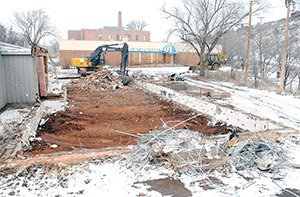Work underway to tear down Fort Defiance hospital
By Carolyn Calvin
Navajo Times
FORT DEFIANCE, Feb. 5, 2011

(Times photo - Leigh T. Jimmie)
The non-historic portions of the Fort Defiance Indian Hospital such as the modular building that was once the dental clinic are being demolished on Tuesday in Fort Defiance.
Jenny Notah, spokeswoman for the Navajo Area Indian Health Service, on Tuesday said the first phase of demolition at the compound began last month.
"We are considering further demolition activities on the compound which includes the historic buildings," she said. However, "we recently received inquiries from the Navajo Nation and a local nonprofit asking about possible use and transfer of the buildings."
Transfer of the buildings is a long process requiring additional discussions, Notah said.
The IHS plans to "relinquish its interest in the land back to the Navajo Nation," Notah said. "Once the land is relinquished, the Navajo Nation will determine its future use."
Rumors had surfaced last week that the historic buildings on the compound dating back to 1938 were going to be demolished "brick-by-brick" despite its historic value.
The buildings have remained vacant since the Fort Defiance Indian Hospital relocated to a new 245,000-square-foot facility in August 2002.
The community where the hospital is being demolished - Fort Defiance - boasts a long history.
According to documents on file at the Navajo Nation's Historic Preservation office, in August of 1851, Edward T. Sumner established a military post on the site of Ft. Defiance to subdue hostile Navajos. The early community was described as "a parade ground surrounded by low adobe and log buildings."
The Army abandoned the fort following the Treaty of 1868. It reverted to civilian control and became the center of governmental and tribal activities among the Navajo.
In the 1880s, Capt. Edward Plumber established the first small hospital and began his search for physicians. In 1882, a boarding school was built to serve Navajo youth.
In 1912, the BIA established an agency and school hospital on the site and with increased demand, the hospital was rebuilt in the early 1920s.
In July 1934, Commissioner of Indian Affairs John Collier hired Dr. W.W. Peter as medical director for the Navajo Service. Peter began work on creating a newer, more modern hospital - the Fort Defiance Indian Hospital - which opened in 1938.
The building was built in the Pueblo Revival style. Nearly all the stone used in the building was quarried nearby and set in place by Navajo workers. On the day of the dedication of the hospital in 1938, it was already overcrowded with 153 patients.
The Fort Defiance Indian Hospital served as the main hospital on the Navajo Reservation until a new 200-bed medical center opened in 1961 in Gallup.

